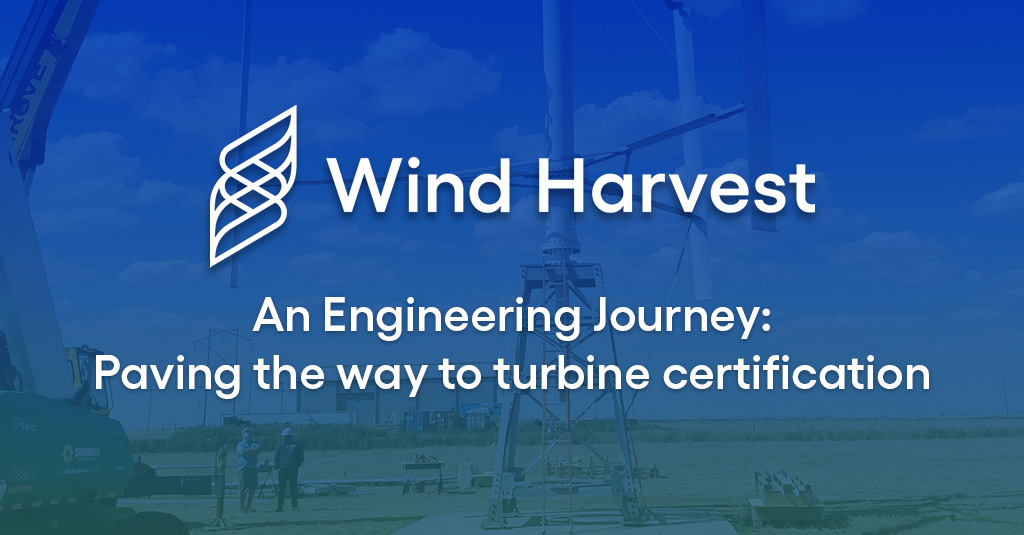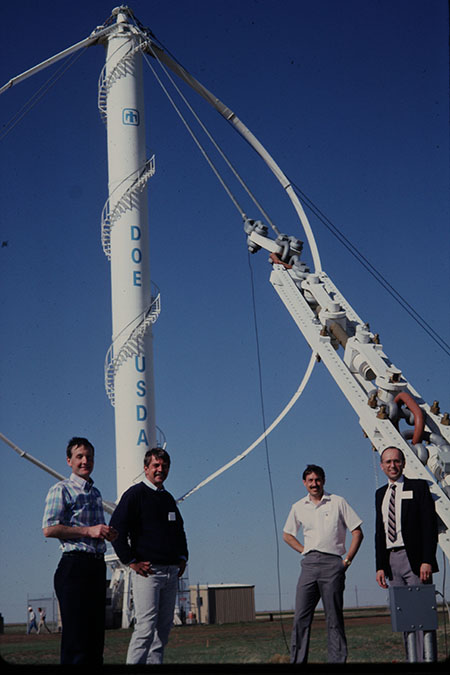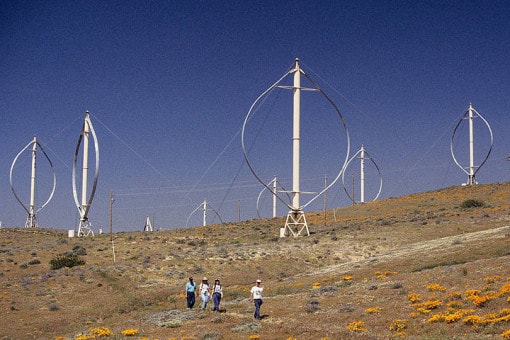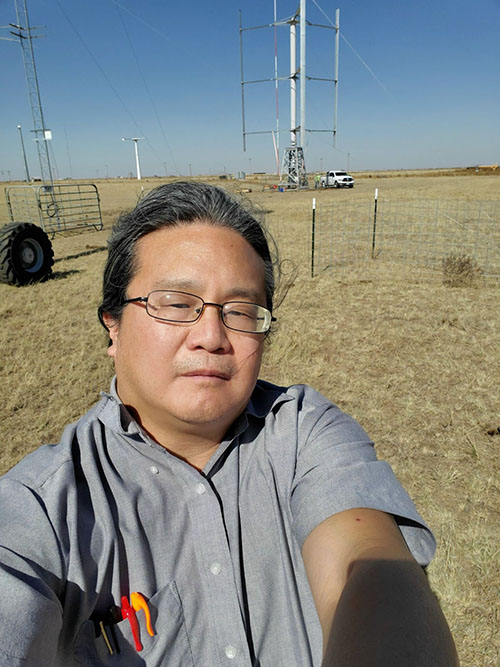An Engineering Journey: Paving the way to turbine certification

9/30/22
Many vertical axis wind turbines have experienced catastrophic fatigue failures. Engineers couldn’t predict the harmonic excitation the machines would realize when finally built and operating. Nor could their engineers accurately predict the loads created by the aerodynamic forces on the blades through their full 360-degree rotation. Enter Dr. David Malcolm, who will pave the way to turbine certification.

David Malcolm, Pau lKlimas Paul Veers Paul Penna (L-R) 1988 Bushland TX, Sandia National Labs 34m Darrieus “Test Bed” turbine.
With his Ph.D. in Structural Engineering and experience working on earlier Canadian Indal Technology versions of VAWTs, David came in to help when five hundred 100-300 kW FloWind “egg-beater” VAWTs started to suffer fatigue issues in the late 1980s. The blade arm-to-blade connection failed; the engineers had not accurately predicted the loads and forces. David and his team found a way to identify the problem using computer modeling codes that Sandia National Labs had started developing.
Unfortunately, FloWind went bankrupt before the repairs could be made and left a negative impression about VAWTs on the wind industry. David, however, learned a great deal.
When David retired after a 40-year career working for the leading engineering companies on horizontal and vertical axis wind turbine dynamics and load issues, Kevin Wolf asked him to work for Wind Harvest. David, like any scientist or engineer, was excited about being able to validate and tweak his computer codes with real-life field data.
Our Model 3.0 was a massive change from the turbines Bob and Dean Thomas had developed. Their Model 1.0 and 2.0 prototypes were guyed so that the harmonic excitation is controlled by applying restraints at the top and bottom of the mast. Model 3.0, however, was cantilevered. Few large VAWTs had ever attempted this. It was a golden opportunity for David to see how the Sandia-based models he developed would predict such a structure.
Model 3.0 was made without the benefits of David’s models and had a lot of problems. The crossing of a harmonic load with a natural frequency caused the prototype to shake dangerously at 40 RPM, which is near the middle of its operational RPM. Our inelegant solution involved programming the power converter to speed up or slow down the RPM to “jump over” the problem zone. The turbine was redesigned to become Model 3.1, but now our engineers had data from 3.0 that validated what is now Wind Harvest’s aeroelastic modeling codes on harmonic/frequency response, loads, drag, and fatigue life.

FloWind 19m VAWTs in Tehachapi – ~1985
Confidence as a Team
When the products our engineers have created are tested, it highlights their work. With the success of our first crowdfunding offering, we were finally able to build Model 3.1. This allowed David and the team to test their work once more. Jeff Olson and Mark Chang had worked on Model 2.0, spending part of winter during testing on an island off the coast of Finland. Ionut Munteanu was the primary engineer on Model 3.0.

Mark Chang selfie with Model 3.1
Antonio Ojeda was brought in to help when it ran into problems. Dr. Olamide Ajala was thrilled to join the team and bring her vast engineering knowledge and experience to work with David to master the models he’d been advancing. Jeff Willis jumped at the opportunity to help with such a challenging project and work with such an experienced team. And Omar Garcia felt lucky to score an internship with us to help Jeff and Antonio on the ground in 2021.
Last spring, Model 3.1’s data collection and model validation began. You can read about the progress starting with the Feb. 9 blog post at the bottom of the page. First, the “pull test” proved the Frequency Response model had pinpointed the “static” natural frequency. Next, the drag and power performance test showed we had overestimated drag (great news!) and were more exact in predicting loads and power performance. The critical crossing of two frequencies and a resulting resonance showed up just where the Frequency Response model predicted and below the minimum starting RPM of 30.
The confirmed accuracy of the suite of our “aeroelastic” codes is a real breakthrough for the wind industry. It puts Wind Harvest in the enviable position of being able to design Model 4.0 using thrice validated codes —originally with the Sandia’s 34 m ‘Test Bed’ Darrieus VAWT, and then with data from our Models 3.0 and 3.1.
Needless to say, David and the engineering team can’t wait to collect and compare data from the 4.0. If it works yet again as we expect, we will order hundreds of Wind Harvesters and have confidence that they will last well beyond their targeted design life. Yay!
Contact: Jen Hoover, jhoover@windharvest.com
Wind Harvest International, Inc. is a California-based renewable energy technology company, founded in 2006. The company makes, sells, and develops projects for its Wind Harvester brand of H-type turbines, the only known product designed to harvest the highly energetic, turbulent wind that blows 15-80 feet above the ground. Wind Harvest’s wholly-owned financial subsidiary Wind Harvest Pilot Project Inc. raises funds and loans it to the parent company.


